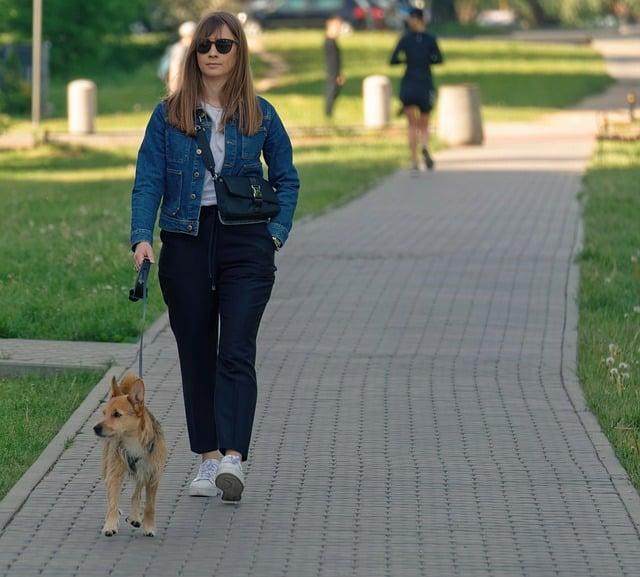In a bustling park, a woman approached a playful golden retriever, eager to pet him. But as she reached out, the dog’s body stiffened, and his tail tucked between his legs. He glanced at his owner, seeking reassurance. This subtle shift spoke volumes: dogs communicate through body language. Averted eyes, a lowered head, or a sudden retreat are clear signs of discomfort. Understanding these cues is essential; it not only protects the dog but fosters a safer environment for everyone. Trust your instincts—dogs know best!
Contents
- Understanding Canine Body Language and Signals
- Identifying Behavioral Red Flags in Dog-Human Interactions
- Creating Positive Experiences to Foster Trust
- Implementing Strategies for Better Human-Dog Relationships
- Q&A
Understanding Canine Body Language and Signals
Understanding a dog’s body language is crucial for interpreting their feelings towards people. When a dog is uncomfortable or dislikes someone, they often exhibit specific signals that can be easily recognized. **Ears pinned back**, **tail tucked**, and **avoidance behaviors** are common indicators that a dog is feeling threatened or anxious in the presence of a particular individual. These physical cues are the dog’s way of communicating their discomfort and should not be overlooked.
Another important aspect to observe is the dog’s facial expressions. A dog that is not fond of someone may display a **tense mouth**, **narrowed eyes**, or even a **lip curl**. These signs suggest that the dog is on high alert and may be preparing to defend itself. Additionally, if a dog frequently turns its head away or avoids eye contact with a person, it is a clear signal that they are not comfortable and prefer to disengage from the interaction.
Vocalizations can also provide insight into a dog’s feelings. Growling, barking, or whining when a specific person approaches can indicate that the dog is feeling threatened or annoyed. **Body posture** plays a significant role as well; a dog that stands stiffly, with its body leaning away from the person, is likely expressing its discontent. Recognizing these vocal and physical cues is essential for ensuring a safe environment for both the dog and the people around them.
Lastly, pay attention to the dog’s overall behavior in the presence of the individual. If a dog consistently seeks to **hide**, **back away**, or **exhibit signs of stress** such as panting or pacing, it is a strong indication that they are not comfortable with that person. Understanding these signals allows us to respect the dog’s boundaries and foster a more positive interaction, ultimately leading to a better relationship between dogs and humans.
Identifying Behavioral Red Flags in Dog-Human Interactions
Understanding a dog’s body language is crucial in identifying their comfort level around people. When a dog feels uneasy or threatened, they may exhibit certain physical cues that signal their discomfort. Look for signs such as **tensed body posture**, where the dog appears rigid and alert, or **avoidance behaviors**, like turning their head away or backing away from the person in question. These actions can indicate that the dog is not at ease and may not appreciate the presence of the individual.
Vocalizations can also provide insight into a dog’s feelings. If a dog growls, barks excessively, or whines when a specific person approaches, these sounds are often red flags. **Growling** is particularly significant, as it is a direct warning that the dog is feeling threatened or annoyed. Additionally, if the dog is **snapping** or showing their teeth, it’s a clear indication that they are uncomfortable and may feel the need to defend themselves.
Another important aspect to observe is the dog’s tail position and movement. A dog that is feeling anxious or fearful may tuck their tail between their legs or keep it low and still. Conversely, a wagging tail does not always mean a dog is happy; if the tail is held high and wagging stiffly, it can signal agitation or excitement that may not be positive. **Ear position** is also telling; ears pinned back against the head often indicate fear or submission, while ears perked forward can suggest curiosity or aggression, depending on the context.
Lastly, consider the dog’s overall behavior in the presence of the person. If the dog consistently avoids interaction, seeks refuge behind their owner, or displays signs of stress such as panting or pacing, these behaviors are significant indicators of their discomfort. **Recognizing these behavioral red flags** is essential for ensuring a safe and positive environment for both the dog and the people around them. By being attentive to these signs, you can help foster healthier interactions and prevent potential conflicts.
Creating Positive Experiences to Foster Trust
Understanding a dog’s feelings towards a person is crucial for fostering a harmonious environment. When a dog feels uncomfortable or threatened, it often communicates this through body language and behavior. Observing these signals can help you identify when a dog does not like someone, allowing for proactive measures to create a more positive experience for both the dog and the individual involved.
Common signs that a dog is not fond of a person include:
- Averting gaze: If a dog consistently looks away or avoids eye contact, it may indicate discomfort.
- Tense body posture: A dog that stands rigidly or has its tail tucked may be feeling threatened.
- Growling or barking: Vocalizations can be a clear warning that the dog is unhappy with the presence of a particular individual.
- Backing away: If a dog retreats or tries to put distance between itself and the person, it’s a strong signal of disapproval.
Creating positive experiences is essential for building trust between a dog and a person. This can be achieved through gradual introductions, allowing the dog to approach at its own pace. Engaging in activities that the dog enjoys, such as playtime or treats, can also help to foster a sense of safety and comfort. By ensuring that interactions are positive, you can help the dog associate the person with enjoyable experiences, gradually changing its perception.
Additionally, it’s important to respect the dog’s boundaries. Forcing interactions or ignoring signs of discomfort can lead to increased anxiety and mistrust. Instead, encourage the person to remain calm and patient, allowing the dog to dictate the pace of the interaction. Over time, with consistent positive reinforcement and understanding, a once apprehensive dog can learn to trust and even enjoy the company of those it initially disliked.
Implementing Strategies for Better Human-Dog Relationships
Understanding a dog’s feelings towards a person is crucial for fostering positive interactions and ensuring the well-being of both the dog and the individual. Dogs communicate their discomfort or dislike through a variety of behaviors. Recognizing these signs can help prevent negative encounters and promote healthier relationships. Some common indicators include:
- Averting gaze: If a dog consistently avoids eye contact with a person, it may indicate unease or disinterest.
- Tense body language: A dog that is stiff, with raised hackles or a tucked tail, is likely feeling threatened or uncomfortable.
- Growling or barking: Vocalizations can be a clear warning sign that a dog is not fond of someone’s presence.
- Backing away: If a dog retreats or tries to distance itself from a person, it’s a strong signal that they are not comfortable.
Additionally, a dog’s behavior can change dramatically in the presence of someone they dislike. For instance, they may exhibit signs of stress such as panting, pacing, or excessive licking of their lips. These behaviors are often subconscious reactions to anxiety and can indicate that the dog feels threatened or uneasy. Observing these subtle cues is essential for understanding the dog’s emotional state and ensuring their comfort.
Another important aspect to consider is the dog’s past experiences. A dog that has had negative encounters with certain individuals or types of people may carry that fear into future interactions. This history can manifest in various ways, such as a dog being overly cautious or defensive around strangers. Recognizing this can help caregivers approach the situation with empathy and patience, allowing for gradual acclimatization.
Ultimately, fostering a positive relationship between a dog and a person requires awareness and respect for the dog’s feelings. By paying close attention to their body language and behavioral cues, individuals can create a more harmonious environment. Encouraging positive interactions through gentle introductions and rewarding calm behavior can help build trust and improve the overall relationship between the dog and the person they may initially dislike.
Q&A
-
What body language indicates a dog doesn’t like someone?
Dogs communicate through body language. Signs that a dog may not like a person include:
- Stiff body posture
- Raised hackles
- Avoiding eye contact
- Turning their head away
- Tail tucked between the legs
-
How does a dog react when they dislike someone?
Dogs may exhibit various behaviors when they dislike a person, such as:
- Growling or barking
- Backing away or trying to escape
- Showing signs of aggression, like snapping
- Excessive licking of lips or yawning as a stress signal
-
Can a dog’s dislike be situational?
Yes, a dog’s dislike can be influenced by specific situations. Factors include:
- The person’s behavior (e.g., loudness, sudden movements)
- Previous negative experiences with similar individuals
- Overstimulation or stress in the environment
-
What should you do if a dog doesn’t like someone?
If a dog shows signs of dislike towards a person, consider the following:
- Give the dog space and avoid forcing interactions
- Encourage positive associations with treats or toys
- Monitor the dog’s body language closely
- Consult a professional trainer if the behavior persists
understanding a dog’s body language and behavior is crucial in identifying their feelings towards people. By recognizing these signs, we can foster better relationships between dogs and humans, ensuring a harmonious environment for all.

大家好,我是彼得潘,專業的手法身體治療師。我喜歡探索和研究各種主題,並透過與人工智慧的合作分享專業、實用、有趣的文章。我們定期進行人工審核,以確保內容的準確性。如果您發現文章中有任何不準確的地方,請隨時與我們聯繫,我們會及時糾正。您可以透過 [email protected] 與我們聯繫。



